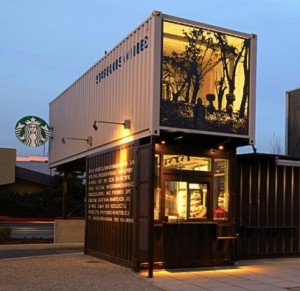Starbucks and “locally relevant” spaces
I remember when the first Starbucks opened in my small, rural hometown in the early 2000s. It was a big thing: people talked about constantly in the weeks preceding and following its grand opening. Some people hated it—it was after all a chain, and it had bought out the lease from underneath the mom and pop pharmacy that had occupied the building for as long as anyone could remember—but in the end, it didn’t really matter. It was an instant success. Of course it didn’t have any competition—no one had attempted to open a coffee shop in town before, and it was strategically located across from the Post Office, which until Starbucks had been really the only place to go in town. I distinctly remember how foreign it felt when I first visited the new store, and how cool it was to be there, sitting in the dark leather chairs with modernist tables and fatigued, raw brick walls and ambiance lighting and a Starbucks specific playlist pumping music into the store. The interior had undergone such a transformation that I had a hard time reconciling it with my memory of the space as a pharmacy. I learned the names of new sorts of drinks—chai tea latte, iced caramel macchiato, mocha frappuccino, things I had never heard of—and the words felt foreign in my mouth. The instant appeal of Starbucks, of course, was that it provided a place to sit and gossip in a town with no other coffee shops and a single, grungy bar. But I think the appeal ran deeper than that, at least it did for me as a kid. Starbucks was a little piece of the outside world—with its trendy music and sleek interior decoration unlike anything to be found in my hometown, it felt modern and in beat with the rest of the world.
Starbucks lost its appeal, however, when I moved away. It ceased to be a treasured little slice of the larger world and a favorite local watering hole and became, effectively, a public toilet. At least this is how Starbucks is in New York. I rarely patronized Starbucks in New York (except to occasionally buy a rice krispy treat on the run) because the NYC stores are dirty, crowded, and loud. The dark finishes on the modernist tables are chipped revealing the cheap, light wood underneath. Bins overflow and the constant stream of people makes Starbucks an unpleasant place to sit. Instead of feeling uniquely modern, as it did in my hometown, the décor in NYC revealed itself to be an identical, cheap façade, infinitely reproducible and simply tacky. McDonalds with a darker color palate. I, along with most of New York (see http://www.nytimes.com/2011/11/23/nyregion/starbucks-mutiny-exposes-new-yorks-reliance-on-chains-toilets.html), used Starbucks predominantly as a convenient place for a quick pee if I was out in the City for the day. Although I suppose some people, tempted in by the promise of a public toilet, bought a coffee they otherwise wouldn’t have, and although I’m sure Starbucks makes a profit in NYC, I can’t help but feel that in America’s most global city, Starbucks lost its way.
Starbucks seems to recognize this as a risk. There is a new project to design new stores that are “locally relevant”. This article (http://www.fastcodesign.com/1670889/an-experimental-new-starbucks-store-tiny-portable-and-hyper-local#4) provides an interview with one of the designers, Anthony Perez, who has been involved with designing new stores. He discusses how the original idea of the coffee house was borrowed from Europe (delocalized if you will) and then subsequently redesigned (or relocalized) for the American context and then shipped own anew into the global marketplace, at times replacing the very European coffee houses that it borrowed from. The challenge, today, according to Perez, is keeping Starbucks “locally relevant” as changes in the marketplace have made environmentalist and localism high on customers’ list of priorities. He explains that Starbucks has taken on a pilot project to redesign exterior facades and to render Starbuckses both “green” and an organic part of their local environment. To quote the article, “Perez sees this facade as both a literal and metaphorical layer to the building that can make a mass-produced corporate product into a relevant place to the community.” The result is some pretty cool looking new Starbucks buildings.
The article features pictures of a new Starbucks in Denver, but also check out these links to a Starbucks in Seattle made out of a shipping container (http://www.starbucks.com/blog/sustainable-store-design-in-action/1158) designed to emphasize the global connections of the supply chain and to recycle these containers and this Starbucks in Japan (http://www.fastcodesign.com/1669480/an-ultra-cool-japanese-starbucks-leaves-the-seattle-vibe-far-behind#6).
Anyway, it’s interesting to think about the role of designers in the creating spaces in which people consume global commodities and what their role is in creating particular feelings through designing particular spaces.
Contributed by CameronOtt on 09/02/2015








Hi Cameron,
Your discussion about the design of these spaces is very interesting; you might want to have a look at Albena Yaneva’s book Mapping Controversies in Architecture (Ashgate 20102) that ‘questions: How can we conceptualize architectural objects and practices without falling into the divides architecture/society, nature/culture, materiality/meaning?’
An earlier post on the OiM site about containers and container ships is also connected to your topic (you can use the search function on this site) .